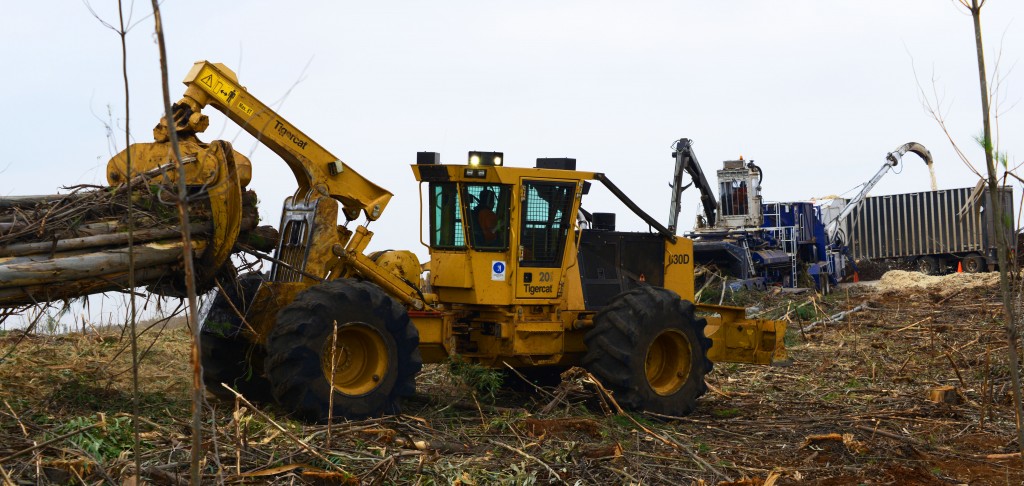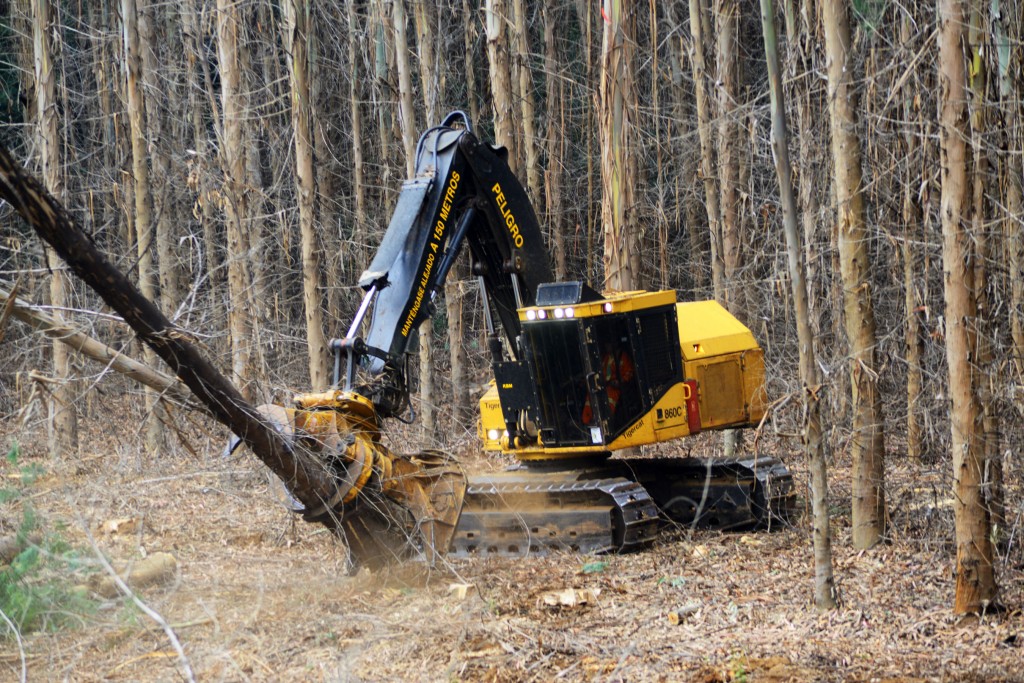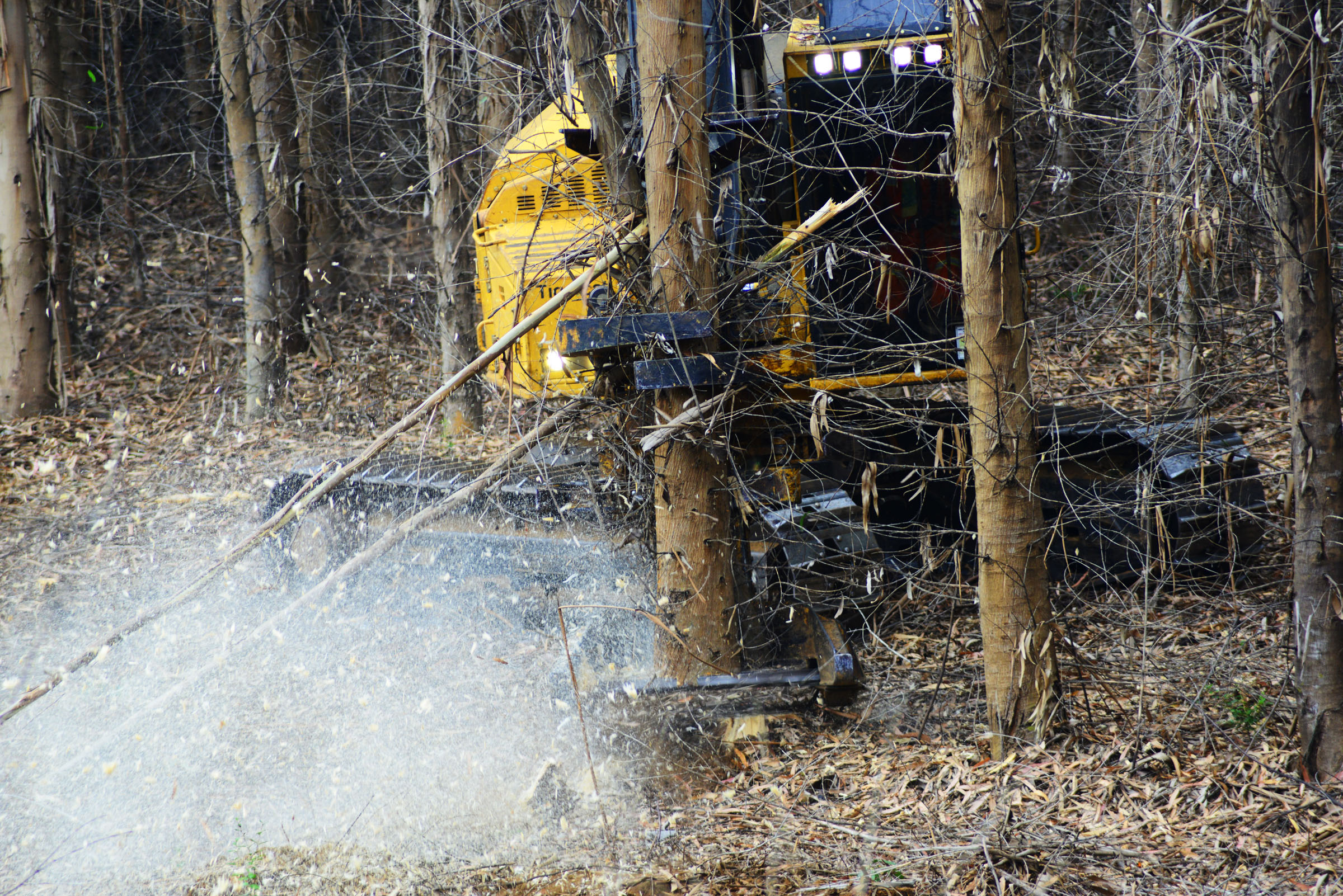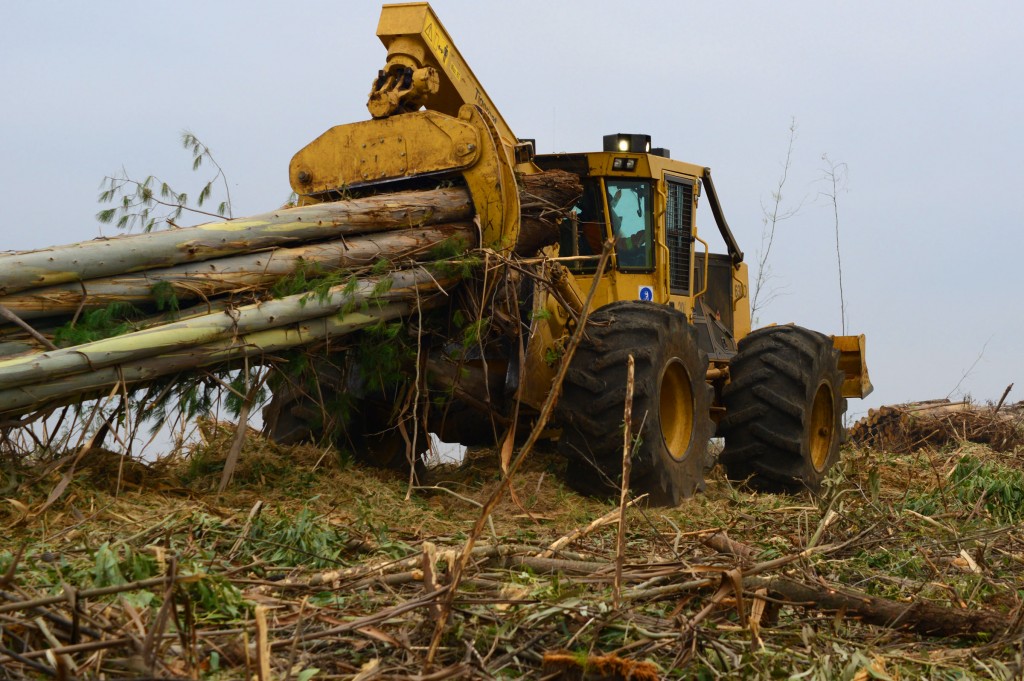Related Content
KBM Chile Infield Chipping
23 October 2011
A KBM in-field eucalyptus chipping operation in Chile, 2013. 860C feller buncher and two 630D skidders.
1st November 2013
KBM owner Daniel Hermosilla talks to BTB about the equipment and human resources
required to produce chips efficiently in Chile.

These high capacity chipping systems are very sensitive to workflow issues and Daniel collects detailed production data to manage and optimize the flow of wood. In very large wood, a 630D can pull enough trees to fill a chip van in as little as two drags.
Owned by Daniel Hermosilla, KBM Chile was established in March 1994 in Los Angeles, Chile. Initially, the company’s focus was silviculture and site preparation. In 2001, KBM expanded into harvesting eucalyptus. Since then, the company has grown to 90 employees and specializes in infield chipping. Three chippers are deployed full time in infield operations, each headed by an operations manager whom in Daniel’s words “owns” the system, operating according to a budget and guidelines.
Daniel sees a lot of advantage in his organizational structure. “There is no chain of command to work through compared to when we had one operations manager. The flattened structure provides better accountability. It costs more in salary expenses but in the long run it is better,” he asserts. “Problems get solved very quickly and the manager works directly with the client 99% of the time right up to the contract manager.”
In total, KBM operates seven systems. The fourth system is stationed at a mill, chipping 7 m shortwood because the mill was having issues with high bark content using its own system. The other three systems operate on a part-time basis as required at each of the infield operations. When extended maintenance or repairs must be performed, the back-up chippers go into production, thereby securing a minimum volume for KBM’s clients.
KBM operates two different types of chipping systems. The older Peterson-Pacific units with the flail and chipping functions integrated into one unit produce around 70 tonnes per hour and can load a truck in as little as 20 minutes.
The newer and higher capacity system is based around a Peterson-Pacific flail and chipper combination that is best suited to larger trees and higher production. This chipper has a capacity of approximately 120 tonnes per hour. But the higher capacity means that the chipper is more sensitive to workflow issues. “It is thirteen minutes to load a truck, so if a truck is ten minutes late, it is a big deal,” comments Daniel.

The Tigercat 860C cutting eighteen year old eucalyptus. While track feller bunchers always open without working new stands, when conditions permit, KBM deploys lower cost wheel feller bunchers.
Many of the plantations that KBM harvests are typically eighteen-years old with 1 000–1 100 trees per hectare. There is currently a lot of Chilean plantation wood in this age range with average piece size as high as 0,85 m3. It is in this wood—beyond optimal single grip harvesting head size—that the large chipper is deployed. The bunchers end up losing production on account of the necessity for double cuts. Daniel figures that KBM will be in this size of wood for five or six years. Then the rotation will fall back to a more optimal 14–15 years. The smaller chipper works in plantations of 650 m3 per hectare and in some cases the system can produce 80 tonnes per hour in ideal conditions. Daniel keeps a close eye on chip van load times. It tells him a lot about the overall efficiency of his operation and he measures this in three ways: total load time, stopwatch timing that takes machine stoppages into account and hour meter load time which Daniel explains, is basically the total hour meter time for the shift divided by the number of loads.
Also important to KBM’s tracking system are the iPads that are installed in the chippers. “We are quite modern in that sense,” says Daniel. Ironically KBM first tried industrial computers but they wouldn’t stand up to the tough operating environment. “So we thought, let’s try an iPad that is $1000 cheaper. We wrote our own software and interface to download the information wirelessly to the mobile office. Then it is synced with the database in the main office.”
Using the iPads, the chipper operators must account for all work stoppages and have a number of pause codes available to choose from. The feller buncher and skidder operators input their data into the industrial computer in the mobile office once per shift and later the information is synced to the main office. “We can use the data to improve the numbers by analyzing the different properties such as the operator, type of wood, the terrain conditions or machine issues. It is basically a management tool that ties into fuel consumption as well.”
Of the many facets of KBM’s operations, Daniel emphasizes the importance of human resource management. Problems related to people must be solved very quickly and that is where KBM’s management structure shines. The operations manager is empowered to solve problems without working through a chain of command and this rapid response keeps the operators happy. Retaining good operators and keeping turnover to a minimum has a measurable positive effect on production, machine lifespan and safety.

Daniel says that this timber has grown beyond optimal size but the company has adapted to it and he expects to be chipping these older stands for the next four to five years.
“In general there is a shortage of operators,” explains Daniel. “We hire and train from scratch. Our system for training was not great but recently we have been focusing on it and it is improving. Now we have training procedures in place and [we teach] if/then scenarios for every conceivable variable or issue that the operator may face.”
Although operators are not responsible for daily maintenance, they must be involved and are required to perform visual inspections, check fluid levels and generally must get to know the machines. “But we don’t want to force them to do maintenance tasks and we do have a separate maintenance crew,” adds Daniel.
The initial training period for a brand new operator is three months. Daniel explains that it takes one and a half years to get to the 80% effectiveness mark and six to seven years to approach 100% effectiveness.
As a matter of necessity, operators are trained on the job. While they may be productive after a short time on an easy site, if any type of complication is added, suddenly the wood flow slows down. Learning how to respond to sudden challenges and complications makes a good operator and this is why the if/then scenarios are so important.
Daniel also explains that less experienced operators are definitely harder on the machines. “They have a hard time with pace when it is hot and we see increased incidence of overheating. It is sort of a turtle and hare thing and you can compare an experienced operator to the turtle. The new operator simply cannot adapt as well from site to site and cannot deal with change. Thankfully we have lots of seven-year operators now.”
Daniel has observed over the years that when he hires experienced operators, they almost seem to fit in too well. “They tend to go with the flow and don’t optimize the machine and minimize the hours. Even though they might be able to work faster and produce more in a given number of machine hours, they adjust their own pace to the general flow of the operation. This has the effect of dragging things out and makes it difficult to improve the productivity of the system.” Standard practice has been to run the machines to 30,000 hours. “Our conditions are easier than say, Canada,” says Daniel. “We find the older machines to be equally productive when they are working but the downtime increases and skidders tend to get beat up the most.” Daniel keeps back-up machines in case of extended downtime and has been considering reducing the lifecycle to 16,000 hours to keep availability rates up while preserving a high resale value.
Operations manager, Martin Durruty, took us to a couple of jobsites, first to see an 860C feller buncher opening up a new stand, then to see the extraction and infield chipping. Martin explains that the 860C opens the stand by first cutting the perimeter. Even on a dead flat site where wheel feller bunchers will perform the felling, it is much more efficient to cut the perimeter with a track machine because it can swing around to throw the trees behind as it creates the corridor. In the large eucalyptus, production rates are about 250 trees per hour.
If the terrain is favourable, a drive-to-tree feller buncher is deployed to cut the rows. Normal production in the rows is 300 trees per hour. In the right terrain conditions, a wheel buncher produces the same as a track buncher, so rubber tire bunchers are used whenever possible. The feller bunchers generally work ahead of the rest of the system. How far ahead depends on many factors. The most significant is related to the optimal drying period before debarking, says Martin.

The skidder operators build up the main trails with brush to combat wet soil and to soften the impact of the stumps.
Martin took us to a second site where the chipper and skidders had just moved in. A single skidder opens the site initially, pulling the bunches that are very close to the deck. Once this wood is consumed and the congestion abates, the second skidder starts up and the two machines alternate between long and short skids to keep the correct volume of wood in front of the chipper. Bark is returned to the cut block and used to form a road or mat upon which the skidders travel. This is especially important in muddy sites and in rocky terrain where the feller buncher cuts slightly higher stumps to preserve tooth life. The thick brush layer softens the effects of the stumps on the skidders and operators. In very large wood, KBM’s 630D skidders can fill a chip van with two 15-tonne drags and the 620Ds accomplish the same with three 10-tonne pulls.
Daniel first recalls seeing Tigercat machines back in 1998 at the Atlanta equipment expo. “I was with my Canadian partner and the name stuck in my head. At the time I was doing site prep with a [Deere] 748.” Then in 2000 as Daniel was contemplating his move into the harvesting business, he began researching machinery and looked up Tigercat on the internet. “Tigercat looked like an interesting brand. I liked the concept and idea.”
The same year Daniel travelled to both Canada and the southern US and saw Tigercat machines working in both countries. “I was up in Thunder Bay and had the opportunity to talk to a Tigercat dealer salesman. Then I went to the southern US and saw [drive-to-tree] feller bunchers. Everyone said how good they were. I got good information from operators and owners and I liked what they said.” At that point, Daniel decided Tigercat was the brand for him.
Upon his return to Chile, Daniel contacted the newly minted Tigercat dealer, Latin Equipment with an already formulated list of equipment requirements. At the time Tigercat was virtually unknown in Chile but that didn’t deter Daniel. “I was not always one to follow the crowd. It depends on if I agree with the crowd or not. I don’t try to be different but I will if I think it is a better way to go. They certainly were not the cheapest. Overall I am very satisfied.”
23 October 2011
A KBM in-field eucalyptus chipping operation in Chile, 2013. 860C feller buncher and two 630D skidders.